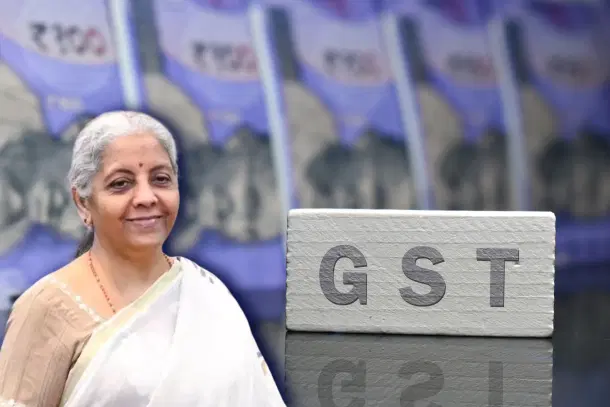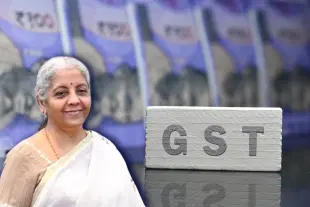Economy
Here Are The Five Ways To Look At The 'Next-Gen' GST Reforms
Aditya Sinha
Sep 04, 2025, 11:23 AM | Updated 01:43 PM IST
Save & read from anywhere!
Bookmark stories for easy access on any device or the Swarajya app.


Reforms are often romanticised as “win–win” solutions, painless correctives that simultaneously advance efficiency, equity, and growth. Political economy, however, teaches us otherwise. Almost every reform redistributes costs and benefits, and is therefore inherently win–lose. The challenge lies not in eliminating losers, but in deciding which groups will bear adjustment costs and which will be cushioned.
Fiscal reforms, in particular, are always redistributive. When tax rates are restructured, some sectors gain competitiveness, while others face reduced protection. Some households see relief in their budgets, while others face a relative shift in burden. What makes the 56th meeting of the GST Council notable is that, for once, the middle-class consumer does not emerge as the loser.
Instead, rate rationalisation has been designed to broaden welfare, stimulate demand, and correct industrial distortions, while relying on buoyancy effects and compliance gains to preserve fiscal balance. Relief for households, structural corrections for industries, and welfare-oriented exemptions indicate that the costs are absorbed elsewhere, while consumers and producers experience meaningful gains.
These reforms could be analysed through five pillars.
The first pillar of reform relates to simplification and rationalisation of the tax structure. India’s GST had previously operated on four slabs of 5, 12, 18 and 28 per cent, alongside a variety of cesses. This system was prone to what tax theorists call rate dispersion, a phenomenon that increases administrative inefficiency and opens avenues for classification disputes.
Seemingly trivial definitional differences, such as whether a snack food constituted a namkeen taxed at 12 per cent or a “prepared food” taxed at 18 per cent, became grounds for litigation. The Council’s decision to move to a structure with two principal rates, 5 per cent for merit goods and 18 per cent as the standard rate, along with a 40 per cent de-merit rate for sin goods, is a pragmatic step toward neutrality and predictability.
Comparative experience indicates that most value added tax regimes globally employ one or two principal rates, precisely to avoid such distortions. India’s adoption of this approach should reduce compliance costs, improve transparency, and enhance long-term credibility.
The second pillar is relief for households and consumers, which highlights the distributive role of taxation. Essentials such as UHT milk, paneer, and all Indian breads are now zero rated.
A wide range of household consumption goods including shampoos, soaps, hair oils, bicycles and kitchenware have been shifted from 12 or 18 per cent to 5 per cent. Aspirational durables and entry-level vehicles, previously taxed at 28 per cent, are now taxed at 18 per cent. These include air conditioners, dishwashers, televisions above 32 inches, motorcycles below 350cc, and small cars.
For middle-class households, these changes translate into lower effective tax burdens across the consumption basket and higher disposable income.
The third pillar concerns welfare-oriented exemptions in health and insurance. All individual life and health insurance policies, including term, unit-linked, endowment, family floater and senior citizen plans, have been fully exempted from GST, compared with the earlier 18 per cent rate. This is significant in a country where insurance penetration remains below 4 per cent of GDP.
Health care has been further supported through zero-rating of 36 life-saving drugs, with 33 reduced from 12 per cent to nil and three reduced from 5 per cent to nil, alongside a reduction to 5 per cent for all other medicines, glucometers and diagnostic kits.
These measures reflect recognition of the fact that certain goods and services generate positive externalities. Improved health outcomes and financial resilience benefit society as a whole, and taxation of such goods imposes regressive costs. The state has signalled its intent to treat them as quasi-public goods rather than commercial commodities.
The fourth pillar addresses sectoral productivity by correcting structural anomalies, most notably inverted duty structures. An inverted duty structure arises when inputs are taxed at higher rates than the outputs produced from them. This leads to an accumulation of unutilised input tax credits, locking up working capital, raising production costs and discouraging value addition.
In textiles, for example, man-made fibres were taxed at 18 per cent while finished fabric was taxed at 5 per cent, generating persistent refund claims and liquidity stress for manufacturers. Fertiliser inputs such as sulphuric acid and ammonia faced 18 per cent GST while finished fertilisers attracted 5 per cent, discouraging domestic production.
These anomalies have now been corrected by reducing fibres and yarn to 5 per cent, aligning fertiliser inputs downward, lowering cement from 28 per cent to 18 per cent, reducing tractors and agricultural machinery to 5 per cent, and cutting renewable energy devices to 5 per cent.
Neutrality, a foundational principle of tax theory, is restored when relative prices reflect economic fundamentals rather than tax distortions.
The fifth pillar concerns fiscal sustainability and cooperative federalism. On the basis of 2023–24 consumption data, the reforms are projected to have a revenue implication of approximately forty eight thousand crore rupees. Yet the Revenue Secretary has objected to describing this as a revenue loss.
He argues that the correct framing is net revenue implication. This semantic distinction matters. Lower rates are expected to generate buoyancy, stimulate consumption, and improve compliance. Evidence already shows that compliance in GSTR-3B filings has improved from about 85 to 90 per cent to nearly 97 per cent as rates have been simplified.
Behavioural economics supports the expectation that consumers will spend more when prices fall, thereby enlarging the base of taxable activity. Businesses, too, are more likely to comply when disputes are reduced. The Council’s reliance on such dynamic effects aligns with the Keynesian view that redistribution toward consumption-heavy households multiplies demand and enlarges the fiscal base over time.
These five pillars demonstrate that GST rationalisation is both redistributive and strategic. As political economy reminds us, reforms always involve losers.
In this case, however, the principal loser is not the household or the middle-class consumer but rather the static conception of the treasury that equates tax cuts with permanent losses. The winners are consumers, farmers, MSMEs and industries previously disadvantaged by inverted duty structures.
The GST reforms of 2017 achieved unification by creating a common market. The reforms of 2025 achieve maturation by simplifying the structure, embedding welfare, correcting industrial distortions, and reframing fiscal sustainability in dynamic terms.
In Musgrave’s framework of public finance, GST is now moving closer to serving not only the revenue branch but also the allocation and distribution branches. It is emerging as a cornerstone of India’s developmental state, advancing efficiency, equity and stability in concert.
Aditya Sinha (X:@adityasinha004) is former Officer on Special Duty, Research, Economic Advisory Council to the Prime Minister. Views are personal.





